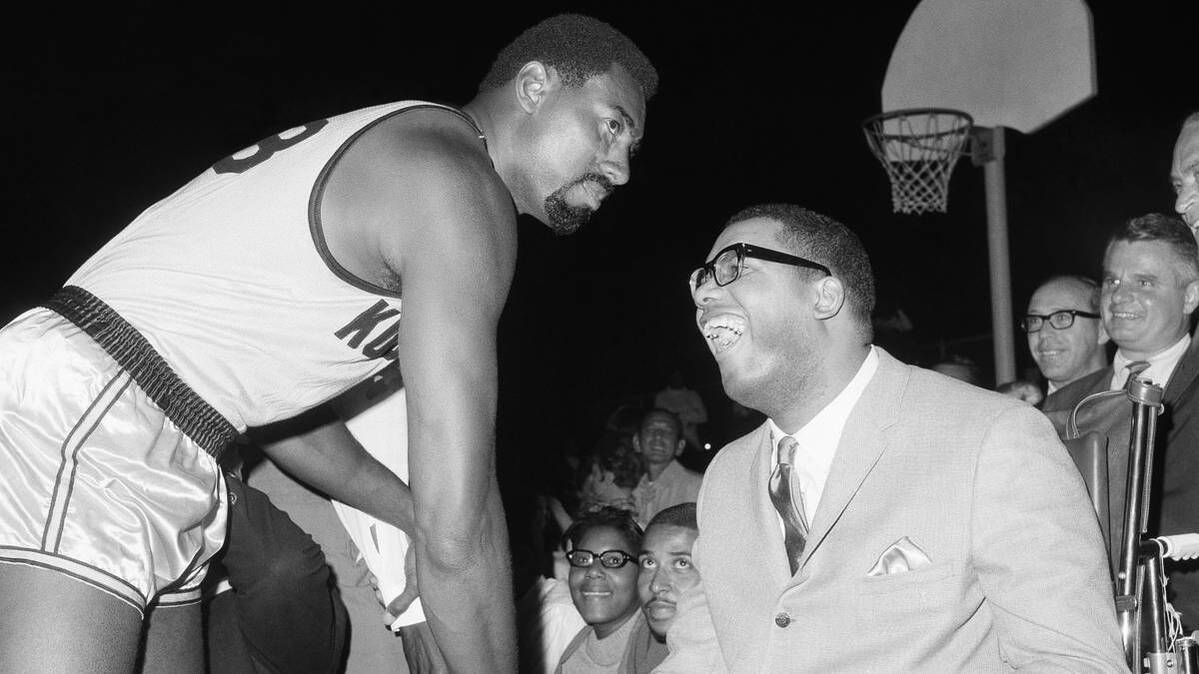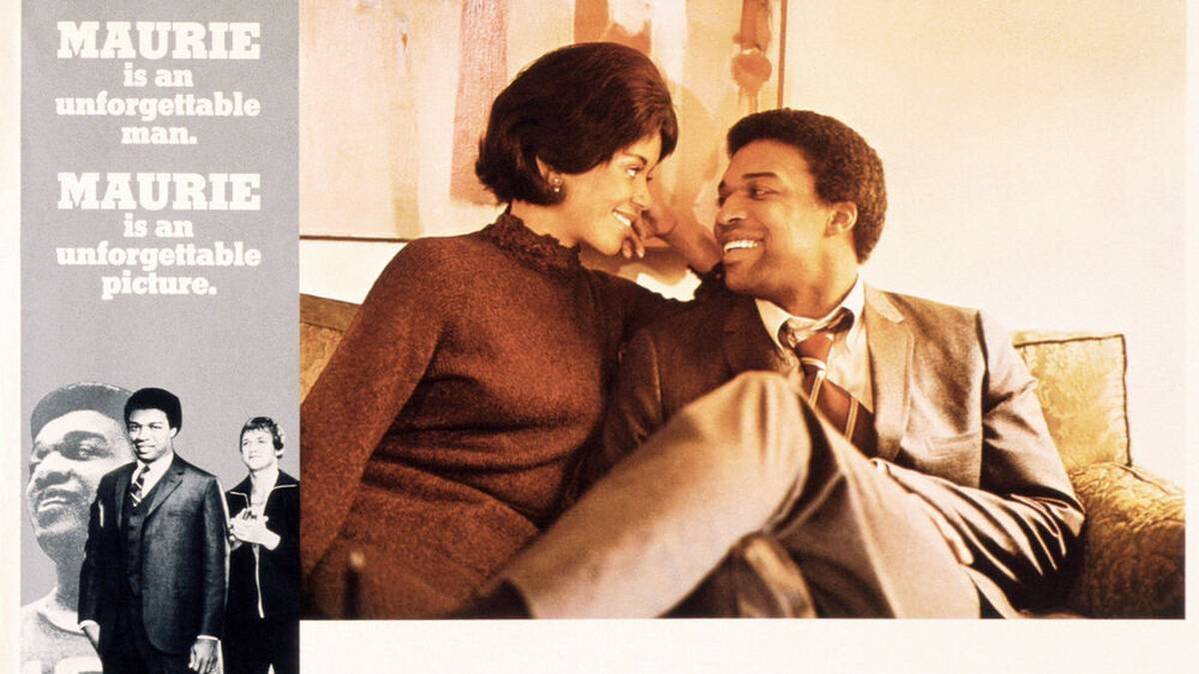Maurice Stokes was on the way to becoming one of the best basketball players of all time. But a tragic accident changed everything. A teammate becomes a hero.
He was probably the best NBA player whose name has never heard many basketball fans: Maurice Stokes. Ex-players and trainers who have experienced him compare him to Michael Jordan, LeBron James or Karl Malone.
Stokes died 55 years ago on April 6, 1970 at the age of only 36 – a tragic accident was preceded twelve years earlier, which probably changed not only his but also the history of the NBA.

Maurice Stokes (right) and Wilt Chamberlain in a benefit game
Stokes creates historical on college
But one after the other: Stokes, who grew up in poor conditions in Pittsburgh, made a name for itself for the first time at the college. In the first game with the little St. Francis College, he got 32 points and 28 rebounds against the Villanova Wildcats. In his junior Year, he got 23 points and 22 rebounds on average.
At the National Invitation Tournament, held in the Madison Square Garden, Stokes led his team to the final Four and managed historical: Although his college failed in the semi -finals, he was appointed MVP of the competition, so his achievements were so unique.
The Harlem Globetrotters then wanted to sign stokes, but he chose the NBA. In the draft, the 2.01 meter Power Forward was selected in position two by the Rochester Royals (predecessor of today’s Sacramento Kings).
One of the best NBA debut of all time
The 22-year-old amazed everyone directly at his NBA debut and put on 32 points, 20 rebounds and eight assists. In one game, the athletic big man even managed 38 rebounds. No wonder that Stokes was voted Rookie of the Year at the end of the season.
In his second NBA season, Stokes grabbed 1,256 rebounds (17.4 per game), which had never been achieved to a player before. After moving the Royals to Cincinnati, Stokes led his team with an average of 16.9 points (TOP 15), 18.1 rebounds and 6.4 assists to the playoffs.
In this way he took second place behind NBA legend Bill Russell and third place behind the Guards Bob Cousy (previous year’s MVP) and Dick McGuire. To this day, only one player in the NBA history has achieved these values in the combination: Wilt Chamberlain.
Compare with Jordan, Malone and LeBron
But more than the numbers, his game was amazed. For many, Stokes was ahead of his time. “The first great athletic power forward. He was Karl Malone with more finesse,” Cousy said about him decades later.
The Ed Kalafat, who was playing at the Minneapolis Lakers, even felt reminded of the basketball goat: “In addition to Michael Jordan, he was probably the best player ever. He could still do everything Michael could do,” said Kalafat once at NBA TV .
Never before had you seen a forward over two meters tall, which dribbled the ball forward instead of the Guards. Stokes was able to play Guard, Forward and Center. Dolph Schayes, who ended his career in 1955 with over 18,000 points when the best thrower of the NBA history at the time, therefore feels reminded of the game of LeBron James or Oscar Robertson.
That Robertson joined the Royals in 1960, which is why not only Stokes’ player Jack Twyman then suspected: “If Maurice had stayed healthy, we might be talking about the Cincinnati dynasty instead of Boston.”
Stokes loses consciousness after falling
But a tragic event in the last game of the season in 1958 turned everything upside down. During the game, Stokes flew over the back of a player, lost the balance and opened his head on the parquet.
Stokes briefly lost consciousness. When he regained it, he continued. At the end of the game, he had collected 24 points and 18 rebounds. There was no serious follow -up examination of his head injury – the first fatal mistake.
The first playoff game in Detroit was coming up three days later. Stokes looked cumbersome and complained of dizziness – but he still achieved a double double. And although he was already very bad, he got on the plane for the return flight.
Shortly after departure, Stokes was already pale and sweated according to Twyman, as if “you had dipped your head into a swimming pool”. Before he lost consciousness, Stokes told his teammates: “I feel as if I had to die.”
When Stokes woke up in the hospital in the hospital after weeks, he was completely paralyzed. Only his eyes and brain still worked. The case on the head had led to a swelling of the brain, which had been further reinforced by the cabin pressure in the plane.
Twyman becomes a savior
While his teammates drove to their respective home after the end of the season, Stokes was alone and center in the hospital. Only the then 23-year-old Twyman continued to take care of his teammate, with whom he agreed with gaps.
In order to be able to better help Stokes, Twyman even became a “legal guardian” and took him in with his wife. “That had never existed – during this time with all the racial problems for an African American who had no one,” said Robertson later.

The story of Maurice Stokes was filmed
But how should Twyman put the medical costs of $ 100,000 per year for therapy and medicine with a salary of $ 15,000?
The later Hall of Famer explained compensation for his friend by the NBA, founded the Stokes Foundation and organized Hotelier Milton Kutsher an annual benefit game, the income of which went into the medical care of sports Invalids.
The fate of Stokes touched so many colleagues that the games – which took place decades after his death – reminded of all -star Games. Chamberlain even interrupted his vacation in France in order to be there.
One last great honor
In the meantime, Stokes had fought for years to speak a little with great effort, paint and use the typewriter. For over a week he typed on his first sentence to Twyman. This was: “How can I ever thank you for everything you did?”
The last big honor that Stokes himself still witnessed took place in 1969. His former college St. Francis invited him to the festival for the construction of a new sports center. He was asked if he didn’t want to be the namesake. Stokes cried with joy before he agreed.
But Stokes was never allowed to see the building with his name. Ten months later, he died of a heart attack at the age of only 36. “He worked so hard that his heart gave up,” said Twyman.
After Twyman fought for decades, Stokes was included in the Hall of Fame in 2004.
In his speech, the moved Twyman said: “Whatever I did for Maurice, he gave me ten times. Just let me say: Congratulations buddy, you did it.”